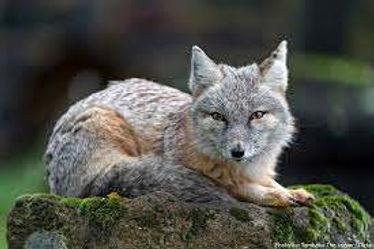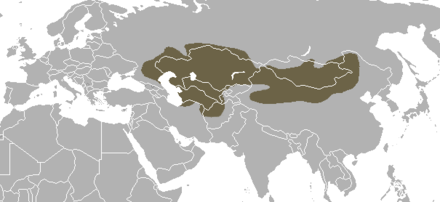Corsac Fox(Vulpes corsac)
The Corsac fox is a medium-sized fox, with a head and body length of 45-65 cm, and a tail 19-35 cm long. Adults weigh from 1.6-3.2 kilograms. It has grey to yellowish fur over much of the body, with paler underparts and pale markings on the mouth, chin, and throat. During the winter, the coat becomes much thicker and silkier in texture, and is straw-grey in colour, with a darker line running down the back.

For a fox, it has small teeth and a wide skull. One source claims that this species can climb trees and has been domesticated in the past. It is reported to have keen eyesight and hearing and an acute sense of smell. It has a number of scent glands, some of which produce pungent odors, although not as extreme as those found in some other species. The glands are found in the anal region, above the base of the tail, and on the paws and cheeks. Corsac foxes are reported to bark during hunting or when threatening rivals, and to use higher pitch yelps or chirps as alarm calls or social greetings. There are three subspecies of Corsac Fox.
Habitat
Corsac foxes live in the central and northeast Asia. They are found throughout Kazakhstan, Uzbekistan, and Turkmenistan, and through all except the northernmost regions of Mongolia. In the south, their range extends into the more northern parts of Iran, Tajikistan, Kyrgyzstan, Afghanistan, and China, and they can also be found in neighbouring regions of Russia.

These foxes inhabit open grassy steppes and semideserts and avoid dense vegetation and mountainous regions. True deserts with drifting sands are also avoided, as are snowfields more than about 15 cm (6 in) deep. Corsac foxes generally stay far away from human disturbances.
Three subspecies are currently recognised:
-
Northern Kazakhstan, southern Siberia.
-
Northern Uzbekistan, Caucasus.
-
Southern Uzbekistan, Turkmenistan, China, Mongolia, and neighbouring regions.
Diet
Corsac foxes are omnivorous, mainly carnivorous animals. Their diet consists mainly of insects and small rodents, such as voles, gerbils, jerboas, hamsters, and ground squirrels. They may also eat larger prey, including hares and pikas, and will scavenge for carrion and human refuse. They do occasionally eat fruit and other vegetation, especially when animal prey is scarce. As an adaption to the arid climate in which they live, Corsac foxes need little water to survive, obtaining most of the moisture they need from their food.
Breeding
The mating season starts in January and ends in March. Males will initially fight for access to females, but eventually establish a monogamous bond, and assist in the raising of their young. The mother initially creates a birthing den, which is sometimes shared with other pregnant females, but moves her young to new burrows several times after they are born. Typically, two to six young are born after a gestation period of 52 to 60 days, although cases of ten kits being born in a single litter have been reported. Newborn kits weigh around 60 g, and have fluffy, light brown fur that turns yellowish as they age. They are born blind, and open their eyes at around two weeks of age; they begin to eat meat at four weeks, and emerge from the den shortly after. Corsac foxes reach sexual maturity within 9 to 10 months and reproduce in the second year of life. They live up to 9 years in the wild.
Population
According to the IUCN Red List they are classed as Least Concern(LC). The Corsac Fox is generally a widespread and common species. However, there are no range-wide estimates of population size and few details are known about the characteristics of regional populations. Most information on population trends is based on harvest numbers and observations. Some accounts suggest that Corsac populations fluctuate greatly over short periods of time, often in response to climatic events (e.g., cold winters with high snowfall). One report indicated that numbers can drop tenfold within the space of a single year. By comparison, in favourable years, numbers can increase by the same margin, but more within a three- to four-year period. Population changes have also driven by intensive harvesting for furs. Harvest levels have varied by country and probably reflect population trends.
Threats
The primary threat to Corsac Foxes is over-harvesting. Throughout most of their range, Corsacs are hunted intensively for their pelts. Hunting has been a traditional (and commercial) activity in most range countries and harvest numbers have historically been large. For example, up to 50,000 foxes were harvested in Russia in some years during the 20th century (one record even indicated 135,700 skins were tanned in 1923/24). Similarly, in Mongolia, an estimated 1.1 million furs were sold to the Soviet Union from 1932 to 1972 with a peak trade of 62,926 in 1947. Over-harvesting resulted in hunting bans in both countries at times to allow populations to recover following periods of intensive hunting. Since the collapse of the Soviet Union, societal change has resulted in few regulations on hunting in several range countries, which has been exacerbated by growing commercial markets for fur. As a result, over-harvesting and illegal trade in international markets has been a growing concern for the species. Other threats include overgrazing by livestock and landscape development (e.g., roads, houses, mining), which may reduce habitat quality for the species. The decline of marmots may also impact the species in some areas, as Corsacs often use marmot burrows as daytime resting locations. Further studies on the impacts of land use/development and interactions with other species are needed.
Conservation
Not listed on CITES Appendices. Hunting of Corsac Foxes is regulated by special national legislation, in which the species is considered a fur-bearer species (Russia, Kazakhstan, Turkmenistan, Uzbekistan, Mongolia). Trapping/hunting is allowed only from November through March in Russia, Kazakhstan, and Turkmenistan. Certain methods of hunting are prohibited, such as digging or smoking animals out of dens, den flooding, and poisoning. Corsac Foxes are protected in strict nature reserves (the highest protection status for the territory) and in national parks in China, Russia, Turkmenistan, Uzbekistan and Mongolia. No special conservation programmes have been carried out. Corsac Foxes breed well in captivity, although few individuals exist in zoos. In the Moscow Zoo, during the 1960s, one pair of Corsacs produced six litters during the time that they remained together.
Gaps in knowledge
There are several aspects of this species' biology that require investigation, including social organization and behaviour, distribution and population status in different regions, interactions with other species (e.g., marmots), and the impacts of hunting/trapping and landscape development.